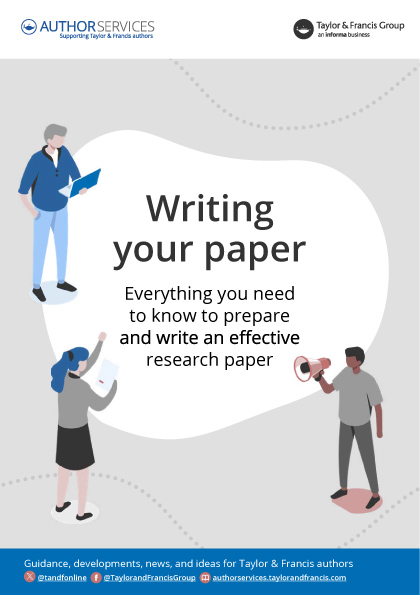5 practical tips for writing an academic article
No matter your subject area, writing an academic article can be daunting because there are no shortcuts. When you publish the results of your research, you contribute your knowledge to your field which is important for career progression.
A survey was sent to over 700 researchers and authors who downloaded the Taylor & Francis publishing journey free guides to find out more about their pain points when writing a paper for publication.
This blog post was created from what they shared about their writing obstacles and how they overcame them by downloading and reading our Writing your paper free guide.
Read on to find out practical tips for writing an academic article. These tips helped your fellow academics overcome their research writing challenges.
1. Where to start when writing a paper

It is ideal to first select the journal that will be a good fit for your research before you start writing your paper. Because when you have a target journal in mind, you have the opportunity to understand the target journal’s aims and scope, as well as the instructions for authors.
One of the hardest parts of writing a paper is placing yourself in the mindset of the reader. So, getting familiar with your target journal will give you all the essential information you’ll need to know about its readership. This information is a useful guide on how to communicate your research while you prepare your manuscript.
Download your own copy of our Writing your paper free guide to learn more about what to consider before you get started. There’s also a checklist to work your way through, to help you prepare to write an effective paper.
In addition, here are some tools and resources available to help you work better and smarter when writing a research article.
“The guide was useful in time spent preparing my manuscript according to journal requirement.”
Munib Abdullah Fathe, University of Mosul and University of Sfax
Post information
Related posts
2. Make a plan for your manuscript
A skeleton outline for your manuscript will help you make sure you’ve covered all the content you need to include. Then you can start writing the part you find easiest.
No one sits down to write with a perfect idea of what they’re going to say. You discover what you’re going to say through the process of writing.
Write down what you know, working section by section. Schedule your time properly by setting writing targets for yourself because deadlines can help you get to your first full draft quickly. Remember that your first draft won’t be perfect, so make sure you plan some time to polish it later on. Your priority at this stage is to get it all down.

Depending on your subject, research focus, journal choice, and any number of other considerations, the type of article you write could vary widely. Given this variation, there’s no set formula for structuring your article. But we’ve provided some hints and tips to get you started.
The structure of your article and the sections it includes will depend on both the type of article you’re writing and the subject of study. Take some time to read the section within our writing your paper free guide that will guide you through a step-by-step process on how to write your manuscript.
“At each stage, I received a lot of help from the free guide when writing my two last articles.”
Geir Conrad Tufte, Østfold University College
3.Write to be discoverable

While this may not seem like a priority while writing your paper, you have to keep in mind that when you submit your article you’ll often need to include keywords. These will be used to index your article on the journal or publisher’s website, as well as on search engines like Google Scholar.
These keywords will help others find your article quickly and accurately. They aren’t just for improving your article’s discoverability, there’s a strong correlation between the online hits an article receives and the subsequent number of citations it receives. So, picking your keywords wisely is worth your while.
You will need to include these keywords in your article, abstract, and title. Make sure you write a memorable title that helps readers understand what your research is about at a glance. Your title is what sells your article to potential readers, so it’s an opportunity to make your research stand out. Also write an effective abstract that summarizes your research without going into too much detail, if they’re interested, people can read on.
Find out more on how to choose keywords and write your article with search engine optimization by downloading and reading our writing your paper free guide.
“The free guide highly motivated and developed my interest in publishing my research work! Also guiding and educating me in new and innovative ideas for my future journey to develop my experience of publishing scientific research”.
Asmera Teshome Negeri, Addis Ababa University and Mettu University, Ethiopia
4. Communicate your work effectively
When you’ve finished writing, read it through and ask yourself whether you have expressed what you set out to say. It’s difficult to see your own mistakes from constant interaction with the text so you could also ask a colleague to read through it as well for a second set of eyes. Poor English is one of the top reasons for a desk rejection, so it’s worthwhile to make sure your writing is clear, accurate, and correct before you submit.
Carefully proofread and edit your final draft, making sure your tables and figures are of high quality. Check for grammatical and typographical errors and that every source is accurately and properly referenced. It’s important to check that your work is structured and presented in a way that will help the reader understand your research.
If you don’t feel confident about submitting your manuscript, consider using a professional editing service like Taylor & Francis Editing Services to help make sure that all aspects of your manuscript is of high quality. There are different pre-submission services available, so take your time to choose the ones that meets your needs.
Still not sure about getting professionals to improve your manuscript? Take a look at the key benefits of using an academic editing service.

“The free guide gave me practical tips straight to what is required to be done.”
Dr. Abidemi O Ilori, University of Uyo
5. Finalize the bells and whistles
After reviewing your final draft, check that you have followed instructions and included all that’s required before you submit your article.
While every journal and publisher may have varying guidance, take some time to familiarise yourself with the editorial processes and policies of your target journal at this point. There are important aspects you need to pay particular attention to while you’re preparing to submit your work.
Areas such as the potential of competing interests, authorship, standard of reporting, use of third-party material, and more. You can learn more about these key areas by downloading a copy of the Writing your paper free guide.
Writing a paper is a lot of work. But if you follow the process in this guide, you’ll be able to do it more quickly without a loss of quality.
Learn how to produce a manuscript that will meet your target journal’s standard
“The free guide assisted me in writing my scientific paper as required by the journal in order to shorten the time for reviewing.”
Eslam A. Youssef
Where to next?
If you’ve found these tips helpful, take a look at:
English language editing service for your manuscript – to help you sharpen the quality of your manuscript to meet international standards of scholarly English.
Tips on what to focus on before submitting your article to a journal
Our Insights newsletter – the latest news, tips, and resources delivered straight to your inbox.
